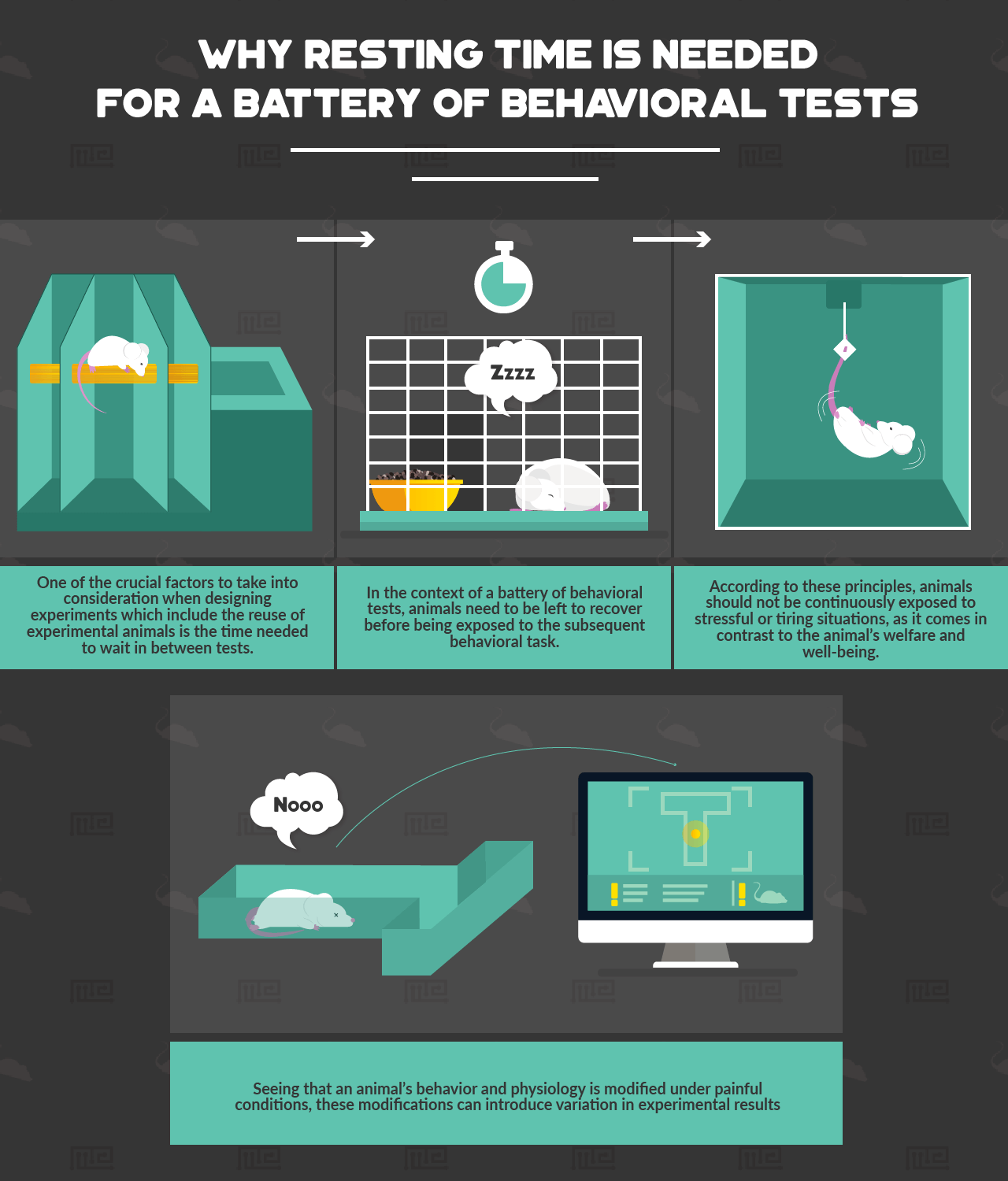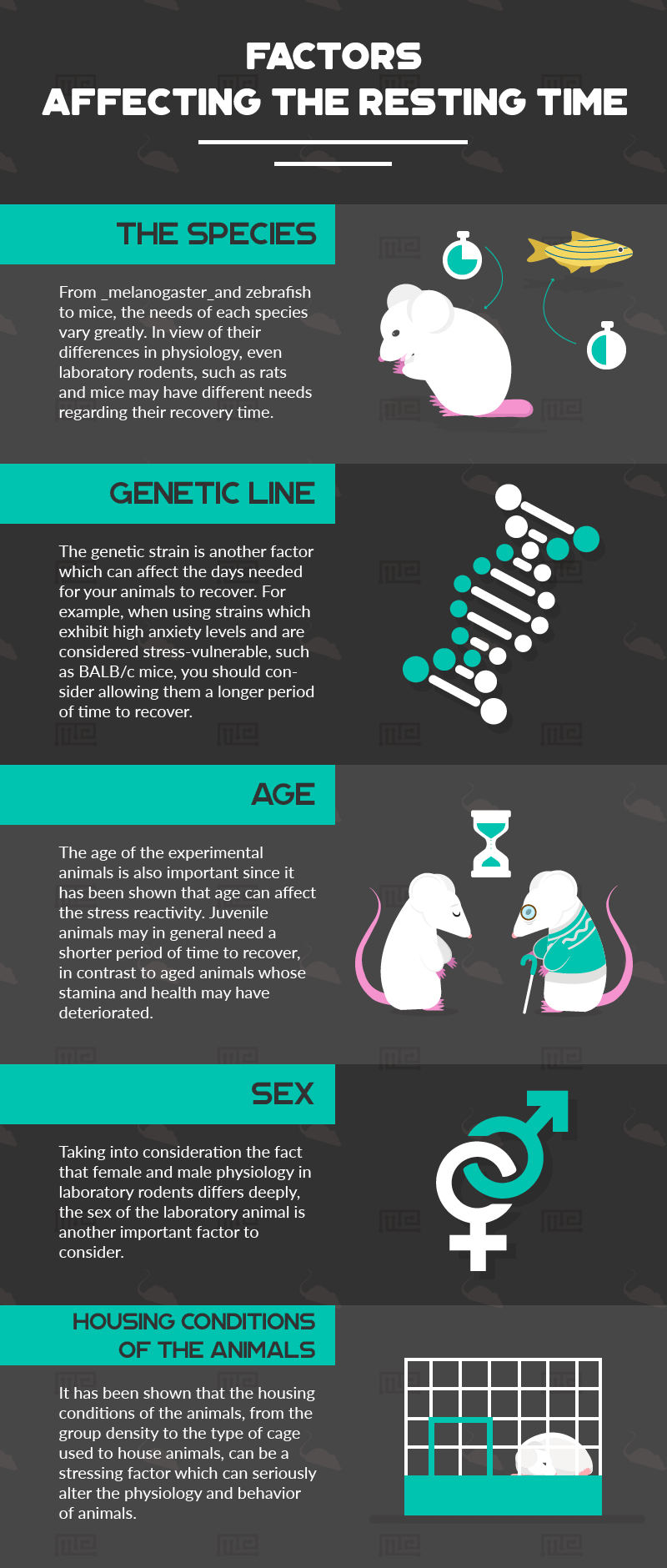If you are a neuroscientist studying the behavioral phenotype of your newly developed knockout mutant line, then the limited number of your valuable animals will quite possibly create the need of designing a battery of behavioral tests.
There are many limitations and important factors to consider while designing your experiment. From the nature of the behaviors which you intend to study and the choice of tests to the appropriate sequence of the tasks, the influencing factors are plenty. Behavior is, without doubt, a very complex and multifractional study which entails many diverse conditions to address. Given that all these factors can affect and alter your results, it is critical to address them with caution and design an unbiased protocol.
Why is Resting Time Needed?
One of the crucial factors to take into consideration when designing experiments which include the reuse of experimental animals is the time needed to wait in between tests. In the context of a battery of behavioral tests, animals need to be left to recover before being exposed to the subsequent behavioral task. This practice is completely necessary to be followed as it complies with the refinement principle of the 3 R’s. The 3R principles include methods which focus on minimizing the animal’s suffering and discomfort.[1] According to these principles, animals should not be continuously exposed to stressful or tiring situations, as it comes in contrast to the animal’s welfare and well-being.
The consideration of the animal’s welfare and the inclusion of valuable time breaks when designing a battery of behavioral tests is not suggested only due to ethical implications. Seeing that an animal’s behavior and physiology is modified under painful conditions, these modifications can introduce variation in experimental results. This variation can seriously weaken the consistency, trustworthiness, and repeatability of your results. An animal stressed by the exposure to the open field test should be left to recover before being exposed to the next task, to tackle any carryover effects from one behavioral task to the next one. If your stressed animal does not perform well in a learning task, you will be left asking yourself whether the results obtained are significant and accurate or they are just a consequence of the previous stressful behavioral task. Indeed it has been shown that previous experience and training history can significantly affect diverse aspects of behavior, such as exploratory behavior, emotionality, nociceptive sensitivity and coordination ability.[2]
How Long Should the Animal be Left to Rest and Recover?
An important way to tackle this issue is to wait between tests when administering multiple behavioral tests on an animal. The exact days needed for an animal to recover is unknown and not officially set. Unfortunately, there is only a limited number of studies focusing on the effect of training history, let alone the time needed to leave between the behavioral tasks in a battery of behavioral tests.
One study has examined the effect of the inter-test interval on the performance of inbred male and female mice during two distinct batteries of behavioral tests.[3] The two behavioral batteries were comprised of the same behavioral tasks and only differed on the recovery time left in between the various tasks. The tasks employed were the following: neurological exam, open-field test, light-dark exploration test, accelerating rotarod test, acoustic startle response and acoustic startle habituation. One battery was designed with 7 days interval between tests and the other one with 1-2 days interval. Their observations suggest that a reduction in the inter-test interval does not have a significant effect on the performance of the subjects on the various tests, except only the performance of the animals on the open-field test. This difference in the open-field results signifies that the neurological test is a rather stressful experience for the animals and should be avoided or if needed it should be performed at the end of a battery.
Factors Affecting the Resting Time
There are many different factors to consider when calculating the days needed to let an animal recover and some of them include:
- The Species: The number of species on which behavioral experiments are being performed gradually increases over time. From melanogaster and zebrafish to mice, the needs of each species vary greatly. In view of their differences in physiology, even laboratory rodents, such as rats and mice may have different needs regarding their recovery time.
- Genetic Line: The genetic strain is another factor which can affect the days needed for your animals to recover. For example, when using strains which exhibit high anxiety levels and are considered stress-vulnerable, such as BALB/c mice,[4] you should consider allowing them a longer period of time to recover.
- Age: The age of the experimental animals is also important since it has been shown that age can affect the stress reactivity. The use of aged animals in behavioral neuroscience is rising, given the focus of studies on neurodegenerative diseases such as Alzheimer’s. Juvenile animals may in general need a shorter period of time to recover, in contrast to aged animals whose stamina and health may have deteriorated.
- Sex: Taking into consideration the fact that female and male physiology in laboratory rodents differs deeply, the sex of the laboratory animal is another important factor to consider when deciding on the amount of time needed to wait between the various behavioral tasks.
- Housing Conditions of the Animals: It has been shown that the housing conditions of the animals, from the group density to the type of cage used to house animals, can be a stressing factor which can seriously alter the physiology and behavior of animals. Animals who at the end of a behavioral task return to a calm and stress-free environment would probably need less time to recover when compared to animals housed in isolation or under non-enriched environmental conditions.
For now, all the necessary information regarding the time needed to leave between the various behavioral tasks can only be drawn from published articles on batteries of behavioral tests. Võikar et al (2004), when testing the effect of repeated testing on two widely used strains of mice, they applied a 3-day interval between each of the 12 tasks in this battery of behavioral tests.[2] Another work which applied a behavioral battery testing on 8 inbred mouse strains was that of Lad et al (2010).[5] For the purposes of these experiments, 2 days were left between the various behavioral tasks performed.
Moreover, Wolf et al (2016) applied five behavioral tasks on a strain of mice commonly used to model Alzheimer’s disease. In between the behavioral tasks they applied different time intervals depending on the nature and the severity of each task. More specifically, between the forced alternation, novel object recognition and Morris water maze tests, they waited for 5 days. However, between the Morris water maze and the radial arm water maze, they only waited for one day. Finally, after the radial arm water maze, they waited 3 days before performing the spontaneous alternation test.[6]
The minimum time interval has been applied by Puscian et al (2014) when testing cognitive abilities of two mice strains modeling autism.[7] During these experimental settings, mice were left 1 day to recover from the handling and the testing procedure.
Contrary to the previous works, McIIwain et al (2001) designed a battery of 8 behavioral tests and left a minimum of 7 days between the different tasks performed. After the acoustic startle response test, they allowed the mice 2-3 weeks to recover before performing the conditioned fear response. Similarly, between the conditioned fear response and the Morris water maze, they left 2 weeks of recovery time.[8] Feyissa et al (2017) followed the previous example and left a time interval of 1 week between the various behavioral tests performed.[9]
In conclusion, the available literature suggests various time intervals between the different behavioral tasks. A general suggestion would be to wait a minimum of 3 days before administering the next behavioral test to an animal. Given that it is not always practical and realistic to wait for one or even two weeks before exposing the animal to the next behavioral task, the researcher should consider applying the most common resting time found in the references. The time needed to wait before administering the next behavioral task on your animal should be a delicate balance between the needs and the special conditions of each experiment.
References
- European Union, Directive 2010/63/EU of the European Parliament and of the Council of 22 September 2010 on the protection of animals used for scientific purposes., OJEU L 276/33. (2010).
- V. Võikar, E. Vasar, H. Rauvala, Behavioral alterations induced by repeated testing in C57BL/6J and 129S2/ Sv mice: Implications for phenotyping screens, Genes, Brain Behav. 3 (2004) 27–38. doi:10.1046/j.1601-183X.2003.0044.x.
- R. Paylor, C.M. Spencer, L.A. Yuva-paylor, S. Pieke-dahl, The use of behavioral test batteries , II : Effect of test interval, Physiol. Behav. 87 (2006) 95–102. doi:10.1016/j.physbeh.2005.09.002.
- V. Brinks, M. van der Mark, R.E. de Kloet, M. Oitzl, Emotion and cognition in high and low stress sensitive mouse strains: a combined neuroendocrine and behavioral study in BALB/c and C57BL/6J mice, Front. Behav. Neurosci. 1 (2007). doi:10.3389/neuro.08.008.2007.
- H.V. Lad, L. Liu, J.L. Paya-cano, M.J. Parsons, R. Kember, C. Fernandes, et al., Behavioural battery testing: Evaluation and behavioural outcomes in 8 inbred mouse strains, Physiol. Behav. 99 (2010) 301–316. doi:10.1016/j.physbeh.2009.11.007.
- A. Wolf, B. Bauer, E.L. Abner, T. Ashkenazy-frolinger, A.M.S. Hartz, A Comprehensive Behavioral Test Battery to Assess Learning and Memory in 129S6 / Tg2576 Mice, PLoS One. (2016) 1–23. doi:10.1371/journal.pone.0147733.
- A. Puscian, S. Leski, T. Gorkiewicz, K. Meyza, H.-P. Lipp, E. Knapska, A novel automated behavioral test battery assessing cognitive rigidity in two genetic mouse models of autism, Front. Behav. Neurosci. 8 (2014) 1–11. doi:10.3389/fnbeh.2014.00140.
- K.L. Mcilwain, M.Y. Merriweather, L.A. Yuva-paylor, R. Paylor, The use of behavioral test batteries : Effects of training history, Physiol. Behav. 73 (2001) 705–717.
- D.D. Feyissa, Y.D. Aher, E. Engidawork, H. Höger, G. Lubec, V. Korz, Individual Differences in Male Rats in a Behavioral Test Battery: A Multivariate Statistical Approach, Front. Behav. Neurosci. 11 (2017) 1–8. doi:10.3389/fnbeh.2017.00026.


